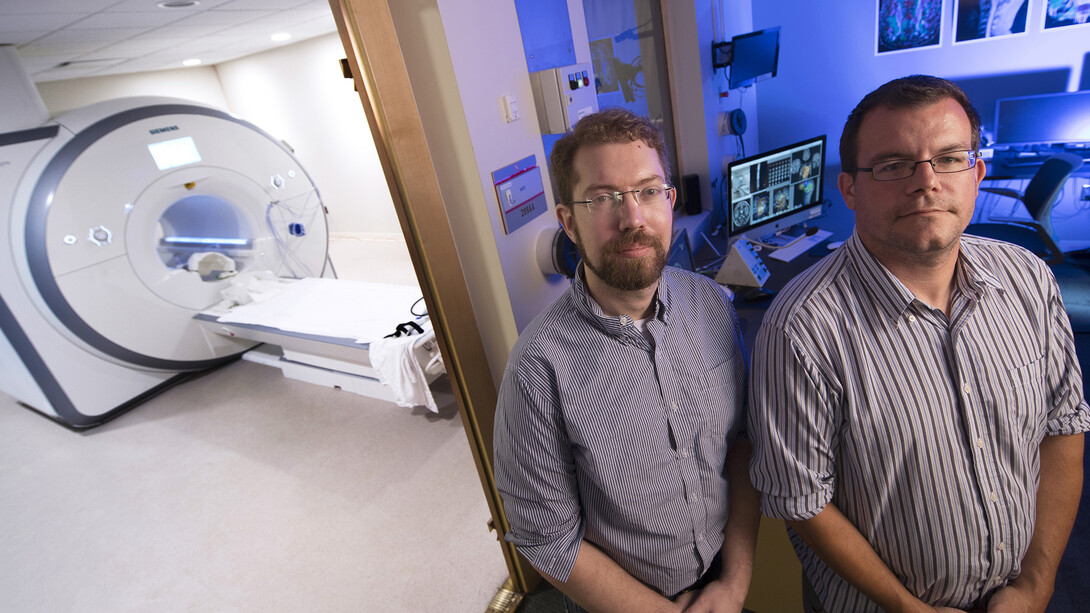
Psychologists from the University of Nebraska will share in a $6 million National Science Foundation grant that will expand the breadth of cognitive neuroscience research capabilities in the Center for Brain, Biology and Behavior and the department of psychology.
The grant was awarded from the National Science Foundation’s Experimental Program to Stimulate Competitive Research, or EPSCoR. It is a four-year, multi-institutional grant that will build a brain trust of researchers from Nebraska, the University of Delaware at Newark and the University of Nevada, Reno, with an overarching goal of building the human intellectual infrastructure needed to excel in cognitive neuroscience research at each institution.
Mike Dodd, associate professor of psychology, and Matt Johnson, assistant professor of psychology, are overseeing the grant activity for Nebraska. They will join four faculty from Delaware and three from Nevada to form the Lincoln-Reno-Newark Coalition, which represents an intellectually and methodologically diverse group of scientists.
The coalition will work together to produce cutting-edge research examining the reciprocal relationship between perception and knowledge – how we pick up new information from the sensory environment, and how our existing knowledge and expectations shape how we perceive the world.
“The scientists from each institution are really complementary in their areas of expertise, so we’ll be able to tackle problems as a group and come up with several ways to investigate them,” Johnson said.
The coalition will include scientists with mastery in functional MRI, EEG, eyetracking, neuropsychology, and modeling, and will fund the purchase of new equipment for neurostimulation experiments at Nebraska.
“The institutions we are collaborating with are very similar to us in that all three, in the past few years, have really started to put a lot of money toward neuroscience research,” Dodd said. “Collectively, we have three smaller, younger research centers that are still growing and developing, but by building these collaborative relationships, the coalition will have at its disposal the resources of a larger and more established research center, benefiting everyone.”
The grant is also focused on training the next generation of neuroscientists from undergraduates through post-doctoral researchers. Undergraduates who show promise will be invited to a “brain camp” to learn about the frontiers being explored in cognitive neuroscience research.
Graduate students and postdoctoral researchers will attend in-depth training workshops on various research techniques and data analysis and will be able to complete rotations in labs at all three institutions.
The new opportunities will be a boon for recruiting graduate students and postdoctoral researchers to the university, and may also be seen as a benefit for recruiting new faculty members, Dodd and Johnson said.
“Answering the hardest and most cutting-edge research questions benefits from a multi-pronged attack that can approach the problem from different angles. That’s tough for newer research centers to pull off,” Dodd said.
By combining the university’s strengths with those of the coalition, the researchers said, Nebraska can expedite the development of research programs and the opportunities offered to trainees, he said.
“This will give the most promising prospective students and faculty hires yet another reason to choose us over other leading research institutions, as well as the resources to nurture their talent once they’re here,” Dodd said. “Building up our intellectual infrastructure will help to sustain and even extend our competitive research advantage beyond the four-year funding period of this grant and well into the future.”
EPSCoR is designed to fulfill NSF’s mandate to promote scientific progress nationwide. Twenty-five states including Nebraska, as well as Puerto Rico, the U.S. Virgin Islands and Guam, compete for EPSCoR funding. Through the program, NSF helps to establish lasting improvements in a state’s or territory’s research infrastructure and research and development capacity.








